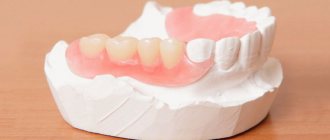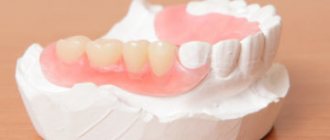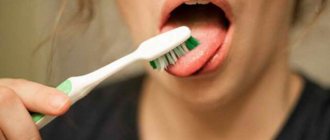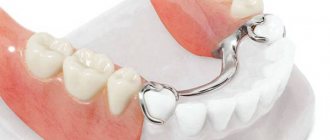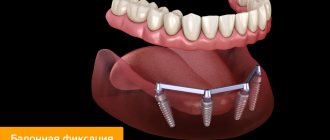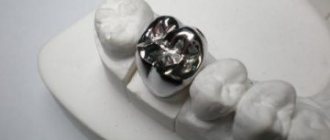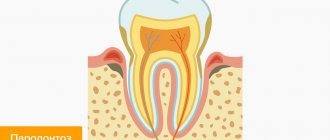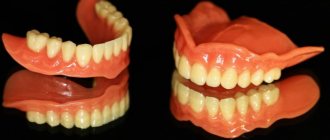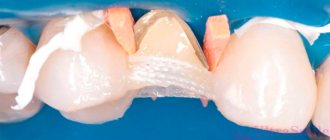What is a splinting clasp prosthesis?
A clasp-type splinting prosthesis is a type of prosthetic structure, the base of which has the shape of an arc and is made of metal. When put on, the product fits tightly to the gum and is attached to the inside of the supporting teeth. Special fastening elements (clasps) provide reliable fixation of movable units.
In addition to the aesthetic side, the prosthesis performs functional tasks - it redistributes the chewing load over the entire jaw. Metal structural elements have a splinting effect, which manifests itself in limiting the mobility of loosening units. By permanently fixing the teeth in the desired position, they are prevented from becoming crooked or even falling out.
Indications for installation
Installation of the prosthesis.
Dental splinting is mainly used to correct the following problems:
- the absence of three units in a row in the dentition, while one of the sides does not have an abutment tooth;
- incorrect position of teeth;
- absence of one unit in the dentition;
- bleeding gums;
- displacement of teeth with exposure of roots;
- the presence of gum pockets and signs of periodontal disease;
- bruxism, deep bite;
- other dental anomalies.
The primary task in diagnosing periodontal diseases is the installation of a bridge process in order to evenly redistribute the load on the supporting teeth. The progression of periodontitis provokes the loosening of units, which requires urgent measures to prevent their loss.
The clasp design firmly holds the teeth in the correct direction with the help of special fasteners and a metal arch.
Main types
If we talk about the method of fixation, then all clasp dentures are divided into 3 groups:
- Clasps . They are held on the jaw thanks to special hooks, which can be seen in the photo. Such fasteners wrap around the abutment tooth. At the same time, its enamel is not damaged. The advantage of this clasp prosthesis is the ability to firmly fix the structure. In addition, it is possible to avoid loosening of teeth and ensure uniform distribution of the chewing load.
- Castles . This type of dentures provides rigid fixation, making the products practically motionless. The main load when chewing falls on the supporting teeth. These dentures consist of two parts. The first is located inside the tooth, and the second is on the tooth covered with a crown. Thanks to this, the design is almost invisible.
- Telescopic . This is the most complex version of clasp prosthetics, because one crown is cemented directly on the tooth, and the second completely follows the contour of the first, but is located on a separate prosthesis. Such a universal product practically does not require correction, even if changes have occurred in the dentition.
Splinting clasp prosthesis
This removable structure is installed when the teeth have become mobile due to various periodontal diseases. The prosthesis restores a beautiful smile and fixes loose teeth.
The advantage of such a clasp design is the restoration of the anatomy of the dentofacial apparatus. This strengthens the periodontal tissue, which means the risk of tooth loss is reduced. The splinting prosthesis is distinguished by its strength and durability.
This design is considered more complex in contrast to the clasp design. Thus, prosthetics are created separately for each client. This takes into account the structural features of the oral cavity, the course of the disease and the location of all loose teeth.
Design Features
Splinting structures have a number of features:
- the base , made of plastic or a combined material, is distinguished by its reduced size, which facilitates rapid adaptation to a foreign body in the mouth and comfortable wearing;
- according to the method of installation, the products are removable and non-removable (the former are easily put on and removed by the patient independently, and the latter are fixed for a long time, subject to constant wear for 2-6 months);
- according to production technology, structures are either solid-cast or soldered (in the first case, a non-separable frame is used, the second option involves stage-by-stage production with subsequent assembly);
- the base part does not come into contact with the palate, which eliminates distortion of speech or taste sensations;
- splinting products prevent bone tissue atrophy; while chewing food, the load is redirected to the entire jaw;
- products are highly durable;
- the design helps restore the anatomy of the dental system.
Making a prosthesis
Manufacturing of a splinting clasp prosthesis.
To make an individual prosthesis that would meet all the requirements and perform its functions, you will need to visit the dentist’s office several times. Several stages go through until the finished product is received.
- Initial visit: the doctor examines the patient’s oral cavity to identify pathology, measures the dentition and prepares supporting elements. Based on a visual examination and diagnostic studies, the specialist outlines a treatment plan.
- In a laboratory setting, impressions are taken of the patient's jaws. This work is performed by a dental technician.
- Based on the impressions obtained, the specialist performs computer modeling of the prosthesis, and a model is cast from plaster and wax. The base and frame for artificial teeth are cast in the same way.
- During the first fitting, inconsistencies and other errors made during modeling are identified.
- Based on the fitted model, a clasp prosthesis is made. At the final stage, the product is sanded and polished.
The design production time is about 10 days.
Installation
The process of installing a splinting clasp prosthesis is conventionally divided into several stages. The list of planned activities includes a plan of treatment procedures, which is drawn up after an initial examination by a doctor.
- After the initial examination, the patient is sent for an x-ray, and is also offered to undergo additional laboratory tests, which allow an accurate diagnosis to be made.
- The selected teeth as supporting elements are prepared. A minimal layer of enamel is removed.
- During the manufacturing process of the prosthesis, the patient is invited to 1-2 fittings in order to eliminate inaccuracies.
- The prosthetic treatment is completed with the fixation of the splinting product and the specialist’s recommendations regarding the care of the structure.
Once every six months it is necessary to undergo a preventive examination to check the integrity and correct fit of the splinting structure. If any problems arise with the denture (breakage, loose fit to the gum), you should make an appointment with a dentist as early as possible.
TYPES OF SPLINTING
Three types of prostheses are actively used:
- Lamellar, which allows you to compensate for deficiencies in the dentition.
- Non-removable - not only eliminate defects, but also distribute the load.
- Removable, including clasp ones.
The latter are good because they allow for reliable fixation of damaged teeth that are prone to displacement, even in a situation where the support for the structure is small.
Depending on the treatment goals, both temporary and permanent splinting structures are used. The choice depends on at what stage of the development of periodontal disease a person goes to the dental clinic, for what purposes the prosthesis is installed and, of course, on the characteristics of the dentition: the presence of support, the type of bite, the general condition of the teeth.
Fastening methods and photos
Clasp dentures have different types of fastenings. The most popular are the following locking elements.
- Clasps - hook-shaped locks extend from both sides of the base, which are fixed to the supporting units. The chewing load is redirected to the supports. The strength of the structure is ensured by the manufacturing technology; the clasps are cast together with the frame. Products with clasp fastening are considered a budget option due to their relatively low price. The disadvantage of the prosthesis is that with an open smile and an emotional conversation, the hooks become noticeable to others.
Clasps
- Guzikova's paws - a design feature is the presence of an endless clasp located on the lingual surface of loose teeth. Products have also been developed with two endless clasps that extend from the vestibular and lingual sides.
Guzikova's paws
- Telescopic crowns are one of the innovative and complex prosthetic systems. The design consists of two parts: one is attached to a metal plate, the other is placed on support units. They are in close contact with each other. Installation of such a prosthesis requires minor grinding of the supporting teeth. The quality of prosthetics largely depends on the professionalism of the doctor.
Telescopic crowns
- Attachments – the fastening consists of micro-locks that are almost invisible in the mouth. They provide reliable fixation of the structure. The load is redirected to the supporting teeth. In dentistry, different types of attachments are used: rail, spherical, crossbar. The type of fastening on the prosthesis is determined by the orthodontist together with the dental technician.
Attachmen
Clasp dentures
This is the main (and, in general, the only) model that is used for splinting teeth. The clasp prosthesis has a durable metal base in the form of an arc (clasp). Thanks to this detail, this prosthetic technique is successfully used to replace several missing teeth, as well as to fix the remaining ones, the mobility of which has become a consequence of the development of inflammatory processes.
The design includes several important elements: an arch, which serves as the basis for supporting the gums, made of plastic, as well as artificial crowns. There are also special fastening elements in the form of hooks, which are made of metal and allow you to secure the prosthesis to the supporting teeth.
According to J. Morris, a professor at the University of Pennsylvania School of Dentistry, soft gum tissue cannot be used exclusively to secure a partial denture. The prosthesis is based on a strong metal base, so its design cannot be in tight contact with the gum. To secure the device in the oral cavity, it is necessary to have at least two supporting elements in the form of living teeth or implants.
Features of a splinting clasp denture for the upper and lower jaw
Prosthetics on the upper jaw are performed mainly with clasp dentures. This is due to the following qualities of the product:
- high strength;
- the palatal space does not close completely;
- during the period of adaptation, the gag reflex is not observed;
- the development of prosthetic stomatitis is excluded.
Splinting structures are recommended for restoring dentition in which one or more units are missing. If all teeth are missing, a decision is made to install implants (at least four). Prosthetics with splinting products on the upper jaw are performed in the presence of loose units, their anomalies, as well as for therapeutic purposes in case of periodontal diseases.
Products for the upper jaw are made from openwork casting. The main material for the arc is predominantly a medical alloy. The technique of installing a prosthesis is complex, so it is important that the doctor has the skills and knowledge to perform the job efficiently.
Prosthetics on the lower jaw are carried out faster and easier , therefore all types of clasp dentures are used to restore the dentition. The design is simpler; it lacks the palatal part. The load during chewing is redirected to the supporting teeth, which actually hold the clasp arch.
Prosthetic splint and clasp prosthesis
Lower clasp denture in the presence of diastema . In prosthetics, there are often cases when, when splinting teeth, one must also take into account the cosmetic condition. In such cases, we show the possibility of taking into account cosmetics in the process of modeling multi-link clasps and, at the same time, not reducing the significance of this bus. When modeling a cast multi-link clasp both on the lower jaw and on the upper jaw, you can take into account the gaps (diastema) of the dentition when modeling and connect the links of the splint with an additional link or branch (Fig. 49).
A prosthetic splint used for focal periodontal disease with a progenic ratio . In the treatment of deep incisal overlap, complicated by focal periodontal disease, pathological abrasion of a group of chewing teeth and a decrease in the occlusal height of the progenic relationship of the jaws, it is advisable to use a removable splint with occlusal pads in the area of chewing teeth lined with plastic. It allows you to restore the correct occlusal height and, using a system of multi-link clasps, relieve overload from teeth affected by periodontal disease (Fig. 50).
Removable plastic splint . Based on the casts taken, models are cast from low-melting metal or supergypsum. The cast models are placed in the central occlusion and plastered into the articulator. The teeth are covered with wax 0.5-0.6 cm thick. The cut out arched wax plate is lowered into water (temperature 50-60 °C). After the wax plate becomes soft and elastic, it is placed on the dentition and squeezed with fingers and a cotton swab moistened with warm water. The articulator is closed, creating an occlusal surface, additionally modeled and attached to the model with molten wax. The verified splint is shortened from the vestibular and oral sides to the equator of the tooth and carefully removed from the model, plastered, and the wax is replaced with plastic. Plastic splints are fitted to the teeth on the model. For finished splints, the occlusal relationships are specified using carbon paper (Fig. 51).
A type of tire made of plastic. When making it, a model is cast from a low-melting metal or from a more durable plaster based on the casts taken. The cast models are placed in the centric occlusion position and plastered into the articulator. The teeth on the model are covered with a layer of wax 0.5-0.6 mm thick. A plate of wax is cut out in an arched shape for ease of application to the teeth, then the wax is heated in water at a temperature of 50-60 ° C, placed on the dentition and pressed between the fingers on the teeth with a cotton swab pre-heated in warm water. The plate is then attached to the model using molten wax. After this, the final modeling of the anatomical shape of the teeth begins, taking into account the verification of all lateral movements. The proven modeling of this splint is shortened from the vestibular and oral sides to the equator of the teeth, and then the modeling is removed from the model, plastered in a ditch and the wax is replaced with plastic.
Plastic splints are fitted on models, then fixed in the oral cavity on the teeth and, using carbon paper, the occlusal relationships of the antagonist teeth are specified.
Tire according to N.I. Kollegov . In order to speed up the process of splinting the lower anterior teeth while meeting aesthetic requirements, a splint made of a thin stainless metal plate with a width of 0.2-0.25 mm to 2.8-3 mm has been proposed. To make a groove on splinted teeth, you need to have a special cutter with a diameter of 8 mm and an ordinary disc holder. Using a cutter attached to the disk holder, we cut a groove to a depth of 2.5-2.8 mm along the cutting edge of teeth from 3: to :3 inclusive. A pre-prepared metal plate of the required length and thickness is fitted into the groove, its upper edge is approximately adjusted to the cutting edges of the teeth. Upon completion of all the preparatory work, cement is diluted and the fitted plate is cemented, after which final grinding along the cutting edge and polishing with an elastic small circle are carried out directly in the oral cavity (Fig. 52).
Support-retaining splinting clasps : I - simple Acker clasp; II - with two T-shaped shoulders; III - with combined shoulders; IV - reverse action; V - circular.
Clasps are considered not only as an element of a prosthesis or splint that ensures retention of the prosthesis, but also as a device that redistributes the vertical and horizontal components of chewing pressure. Depending on the design, the clasp loads the tooth or redistributes the chewing load, or splints it. Stabilization is provided by 2/3 of the shoulder length. The retention part of the clasp arm is characterized by springy and elastic properties. The location of the clasp parts and their functional purpose are shown in Fig. 53. The occlusal pad is located in the intertubercular groove. By changing the location and number of pads, you can adjust the direction of the load on the supporting teeth. The stabilizing part of the shoulder is placed on the vestibular and oral sides of the tooth above the common equator line. These parts of the clasp do not spring, and therefore their purpose is to prevent the tooth from moving under the influence of forces at an angle and horizontally. Modification of various clasps is possible.
The retention part of the clasp arm is located under the equator and has spring properties, fixes the prosthesis and keeps the teeth from moving when it is loaded vertically. These parts of the clasp keep the tire from moving. There are a lot of options for support-retaining clasps; their use should be subordinated to the tasks of the clinic.
Removable tire with spring clips . The most difficult part is splinting the upper front teeth. This is explained by the lack of parallelism due to divergence of the dentition due to periodontal disease, and the cosmetic difficulty of making individual splints. The splint proposed by P. S. Rubinov, in which, with the help of spring clamps, it is possible to combine movable non-parallel teeth of the upper jaw into a block with full coverage along the equatorial part of the tooth on the vestibular side, can also be used for orthodontic measures (move, bring closer, install in a more correct position). When making such a prosthesis from AKR-7, the following must be taken into account: the inadmissibility of passing a thick wire between 1:1 teeth, as this causes them to move apart with the formation of three. If the splint is intended for night use, the base of the prosthesis must be made narrower (Fig. 54).
Fixed splints to replace missing teeth . Due to the advanced dystrophic process, individual teeth must be removed or removed, and the remaining ones must be splinted, taking into account the replacement of lost teeth. Such a tire takes on the character of a bridge-like structure. A similar design is made of noble metals, taking into account cosmetic requirements; the frontal areas are lined with plastic. The variety of such tires is significant - on crowns and half-crowns, beams on a pin base, etc. (Fig. 55, and also see Fig. 41, 43).
Tires made of plastic are significantly inferior in strength to tires made of noble metals and alloys. But plastic has positive aspects: good biological tolerance, ease of making splints, if necessary, corrections in the oral cavity are possible, cosmetic qualities make it a valuable material. The strength of the tire can be enhanced by a metal frame. A plastic splint cannot be used on small and narrow teeth, since the cavities for such splints need to be prepared much wider, thereby compensating for their strength.
The frame for the tire is usually made of 0.5-0.7 mm wire. It can be made with loops or in the form of U-shaped brackets, in the area of the last teeth the end is bent, it fits into the distal groove on the teeth. After preparing the cavities and fitting the frame, they begin to manufacture a tire from quick-hardening plastic. The tire is prepared by direct or indirect method.
With the direct method, before treating the teeth, an impression is taken from the oral and vestibular sides in the form of two blocks. Then the necessary cavities are created in the crowns of the teeth and a metal frame is tried on, the cavities are dried, plastic of the desired color is prepared and the cavities are filled with it. The frame is placed so that it fits tightly to the bottom of the groove on the cutting edge and in the interdental spaces, a layer of plastic is also layered on top and pressed with prepared gypsum blocks, having previously moistened them with water or liquid glass.
The indirect method is that all work on the manufacture of the splint, starting from the moment of its modeling with wax, takes place in the oral cavity. To do this, wax is poured onto the frame and a splint is modeled on the teeth. The model is removed using several pins and the accuracy of the imprint is checked. Then they are cast into a ditch, and the wax is subsequently replaced with plastic in the usual way.
You can make such splints using plaster models, on which they are polymerized directly. It is also good to strengthen tires using quick-hardening plastics.
Tires made of wire or casting . To make a dismountable tire, noble and base metals (alloys) can be used. The tire can be made of steel or gold-platinum alloy, platinum up to 12%. This alloy has low shrinkage and is more elastic. The bus is bent from 1.2 mm wire and cast overlays are soldered to it. More accurately, you can make the same tire entirely cast, using a ceramic model that compensates for the shrinkage of the alloy. If the teeth are fan-shaped or there is no relative parallelism of the teeth, it is advisable to use a collapsible splint (Fig. 56).
Tires made from rings . The simplest method of splinting a group of teeth is to use a cap splint. For each tooth, a ring-crown (without a cutting edge) is made, reaching the equator. Before applying the rings, it is necessary to prepare (process) the lateral surfaces of the tooth in such a way that rings adjacent to each other can be placed in the spaces. The thickness of the ring is 0.25-0.27 mm.
Separation is carried out to the equator of the tooth. To avoid a traumatic knot, a small layer of hard tissue is removed from the front teeth. The production of rings and their fitting to the teeth is carried out using the usual method.
After receiving the model with rings, they are soldered, polished and strengthened with cement or epoxy materials on the teeth (Fig. 57).
Features of care
Fastening of the clasp prosthesis (attachment).
Caring for clasp dentures involves performing the same measures as for other types of structures.
Basic rules of care include:
- for hygiene procedures (2 times a day), use a non-abrasive paste and a brush with medium-hard bristles;
- After each meal, use a mouthwash to remove small particles of food;
- clean dentures with a special solution once a day;
- undergo a preventive examination with a dentist at least once every six months in order to identify problems early;
- review your diet, reducing the consumption of sweets, soda, foods with a solid structure, the same applies to sticky and viscous foods.
Compliance with simple requirements extends the life of prosthetic structures, reduces the risk of developing dental diseases, and, importantly, minimizes the risk of prosthetic breakage.
Advantages and disadvantages
Before deciding to install a splinting clasp prosthesis, you should carefully familiarize yourself with the advantages and disadvantages of the design.
| Analysis of splinting clasp dentures | |
| pros | Minuses |
| High aesthetic qualities, skillful imitation of natural teeth. | The option of prosthetics cannot be called affordable. Even the most budget prosthesis will cost at least 40,000 rubles on a turnkey basis. |
| Does not irritate soft tissues of the oral cavity. | The presence of clasps reduces the aesthetic qualities of the splinting product. |
| Prevents bone tissue atrophy. | A prerequisite for this type of prosthetics is the presence of 4 teeth on each jaw, which are used as supports. |
| The installation technology of the structure is simple. | Locks on dentures can break, especially if recommendations regarding the consumption of foods with a solid structure are not followed. |
| Long period of wearing the product without loss of functionality. | |
| Possibility of installing a splinting structure in the presence of periodontitis. | |
| The clasp denture redistributes the load evenly throughout the jaw, which prevents wear of the supporting teeth. | |
| Removable structures can be used not only for medicinal purposes, but also to prevent tooth loosening. | |
| Wearing the splinting product is comfortable due to its small base. | |
| The period of adaptation (getting used to the prosthesis) is short in comparison with other types. | |
| Taste sensations and speech do not change while wearing a splinting product, which is explained by the absence of bridges covering the palate area. | |
Contraindications
This is what a clasp denture looks like in the mouth.
Splinting clasp dentures have a number of restrictions on installation. They mainly concern the following cases:
- pregnancy period;
- the presence of a negative reaction of the body to metal;
- mental disorders (in particular drug and alcohol addiction);
- cardiovascular diseases;
- during the rehabilitation period after undergoing radiation therapy;
- oncological diseases;
- problems with bone tissue;
- respiratory tract diseases.
Prosthetics are also not performed for dental problems:
- low level of oral hygiene;
- inflammation of the mucous membrane and dental tissues;
- shallow depth of the bottom of the mouth;
- atrophy of the alveolar processes;
- when diagnosing a deep bite, but without the possibility of using another treatment method;
- with pathology of the supporting units or their small height, which makes fixation of the prosthetic structure impossible.
Distinctive features
Splinting clasp dentures have a number of characteristic and distinctive features, in particular:
- smaller sizes compared to conventional clasp dentures make splinting structures more convenient and comfortable for patients;
- there are no changes in diction or taste sensations;
- it is much easier and faster for the patient to get used to the installed prostheses;
- the risk of breakdown is minimized;
- the use of such prostheses does not lead to changes in the gums and bone tissue, which eliminates discomfort when wearing a prosthesis.
Price
The cost of prosthetics using a splinting clasp prosthesis varies in each individual case, which is explained by design parameters, type of locking elements and other factors.
Approximate prices for installing a prosthesis:
- product with 2-3 clasps – 50,000-53,000 rubles;
- product with “Bredent” locking mounts – from RUB 90,000;
- elimination of single-end defects with products on MK-1 attachments – from 108,000 rubles;
- elimination of a single-end defect with products made of a special alloy with attachments – from RUB 280,000.
The high cost of splinting structures is due to the high time required to produce the product and the high-tech manufacturing process.
Splinting clasp dentures: before and after photos
A splinting clasp prosthesis performs two functions at once: it helps preserve loose teeth and replaces lost ones. An orthopedic device is made individually for each patient, taking into account the condition of mobile teeth and the number of lost teeth, characteristics of the bite and jaw structure, age, as well as some other factors.
